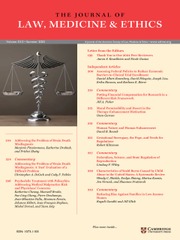No CrossRef data available.
Article contents
Out of Bounds: Physician Licensing Board Disciplinary Cases related to Opioid Prescribing
Published online by Cambridge University Press: 16 December 2024
Abstract
Physician prescribing practices contributed to the US opioid epidemic, leading to increased regulation of opioid prescribing. In some instances, prescribers are unscrupulous or corrupt. They are criminally investigated and subject to prosecution. Less egregious opioid prescribing infractions are addressed through state medical licensing boards. At stake are physicians’ licenses to practice medicine.
- Type
- Independent Articles
- Information
- Copyright
- © The Author(s), 2024. Published by Cambridge University Press on behalf of American Society of Law, Medicine & Ethics


